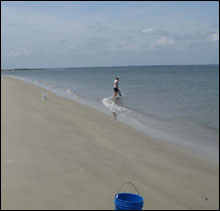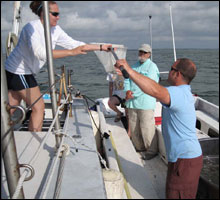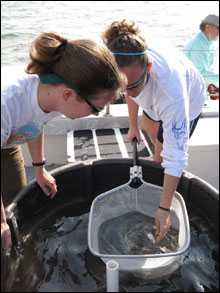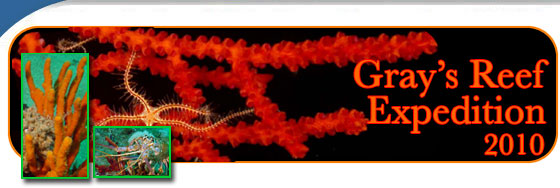Error processing SSI file
|
A Lot of Help From Our Friends...
It is not an overstatement to suggest that without the participation of volunteers and partners, this cruise would not leave the dock. This mission depends upon the assistance of a dedicated group of people that are helping to make every part of the cruise a success. And their work did not start when we left the dock, nor will it be finished when we step back ashore.
 |
| Karin Paquin (UGA Marex Assistant Curator) prepares for the cruise by casting for bait on Wassau Island. The bait will be used to capture grouper and snapper. (Photo: David Patterson)
|
Preparations for an expedition like this one begin months before the ship reaches Georgia waters. One of the projects being conducted aboard the Nancy Foster involves tagging red snapper, scamp and gag grouper. To tag the fish, we first must catch them, and then we have to care for them until they are released with an acoustic transmitter attached. While this sounds relatively straightforward, this requires significant infrastructure and planning. This is our third year of sampling, so we've learned some things and are improving our efforts each year.
In preparation for our 2010 effort, we started working with our partners from the Georgia Department of Natural Resources and the University of Georgia's Marine Extension Service Aquarium early this year. Their ideas about how to successfully capture our study subjects, and how to keep them healthy prior to and after tagging will no doubt result in greater mission success.
 |
| Karin Paquin (UGA Marex Assistant Curator) transfers bait to Devin Dumont (UGA Marex Curator). The bait was captured aboard the R/V Sea Dawg, and brought back to the holding tanks on Skidaway Island by Devin and Capt. John "Crawfish" Crawford (UGA Marine Educator) (Photo: Sarah Fangman)
|
These same folks will be offshore with us every day (most coming out to Gray's Reef via small boat on a daily basis), and are just as excited as we are when we successfully capture and release another study subject. Joining them offshore will be a team of volunteers, including several local recreational fishermen, that will be assisting us aboard the fishing boats. In addition to capturing fish, we are also collecting data on how much effort is required to "land" these fish (called "Catch per Unit Effort" or CPUE). These data can help us estimate how many fish are on the reef. Students from Armstrong Atlantic University and other local area biology programs will be helping to collect CPUE data.
Before the ship or the fishing boats leave the dock, a team of people will be deployed to capture bait for our fishing operations. Partners from the University of Georgia will work in the creeks and rivers around Skidaway Island to try and capture baitfish that our grouper and snapper would like for lunch. This is critical to the success of our mission, as a supply of bait will allow our fishing teams to focus on capturing scamp, gag and red snapper instead of searching for bait! Anything that is caught that cannot be released alive will be used as food for the UGA MECA aquarium - so nothing goes to waste!
 |
| Karin Paquin (UGA Marex Assistant Curator) and Lindsay Bertch (Savannah State University) check the bait caught aboard the R/V Sea Dawg. The Sea Dawg is the University of Georgia Marine Education Center and Aquarium's education, research and collection vessel. A team of volunteers from the Marine Education Center & Aquarium will be capturing bait before and during the mission. (Photo: Sarah Fangman)
|
On board the NOAA Ship Nancy Foster are more partners and volunteers. Gray's Reef supports a program called "Team Ocean" which certifies citizen scientists as NOAA Scientific Divers. These individuals must undergo a rigorous training and evaluation process, which requires significant investment of their time. But once certified they are able to join us for research missions and assist in the important business of underwater data collection. This team of divers will be working alongside NOAA scientists as we assess the habitat around the array of acoustic receivers that are detecting tagged fish. They will also be involved in marine debris surveys, geologic surveys, and inspecting the receiver array to make sure all systems are go. Without this dedicated group of divers, we would not be able to accomplish a fraction of the work planned for this cruise.
Check out the "Meet the Team" page to learn more about some of these wonderful individuals that are helping to make this cruise a success. And check back for daily logs from some of them!
|



